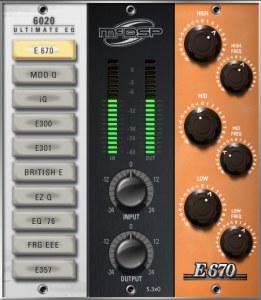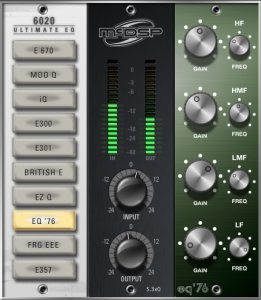Review: McDSP 6020 Ultimate EQ by Zach McNees
Three years ago this month, I reviewed the McDSP 6030 Ultimate Compressor plug-in. The 6030 consists of ten uniquely different 500 series style compressors all bundled into one plug-in. And it has since played a big role in a number of my mixes. So, needless to say, I was excited when I heard about McDSP’s new 6020 Ultimate EQ – a companion unit to the 6030 with ten separate 500-series style EQ modules inside one unique plugin.
As familiar as I am with the 6030, however, I was surprised with what I found in the 6020. Let’s dive in and I’ll explain why…
TECH SPECS: The 6020 Ultimate EQ is available in HD and Native versions. McDSP HD plug-ins support AAX DSP, AAX Native, TDM, RTAS, AU and AS formats. McDSP Native plug-ins support AAX Native, RTAS, AU and AS formats. The 6020 is available for purchase as a stand alone HD ($299) or Native ($199) plug-in, or as part of the McDSP “Everything Pack”. The 6020 is not currently listed as part of the Emerald or Classic McDSP packs.
WHAT IT DOES: As I said above, the 6020 Ultimate EQ packs ten separate EQs modules into one plug-in, each with its own unique sound. As with the 6030, the algorithms of some units in the 6020 plug-in are emulations of classic gear with McDSP’s unique twist, while others were designed from scratch.
IN USE: Visually, the 6020 Ultimate EQ looks identical to its 6030 companion. Each of the EQ modules has the same knob design and color scheme. Apart from the visual design however, the 6020 is an incredibly unique plug-in unlike any other in the marketplace that I’ve encountered. I’ll explain.
When using this plugin, you really have to throw everything you’re used to about the way a plug-in EQ sounds and behaves out the window.
For starters, there are (as of this writing) no numerical indicators of any kind. The knobs for frequency, gain and even the master input and output section are all designed to be used purely by sound and feel. The 6020 demands that you rely entirely on your ears! It’s a simple concept (if not a retro one) not so far removed from the days when engineers spent more time listening to their mixes more than looking at them on a computer screen. Because of this design, the 6020 truly is more of a “feel” plug-in than almost any other plug-in I’ve come across for music production use.
The 6020 offers a very simple set of GAIN and FREQ control knobs for each of the ten EQ units within the plug-in. The Q (or bandwidth) points are fixed individually for each module. Engineers in need of surgical parametric EQ are not likely find what they’re looking for in this particular plug-in, which is okay. The 6020 is a uniquely musical sounding EQ which will no doubt find its place with many engineers as a finesse EQ which can be stacked on top of a more sharply focused parametric EQ for more musical shaping of sounds.
The 6020’s default module is the Fairchild look-a-like E670. The E670’s controls are the most typical of the modules in the 6020 plug-in with five of the ten modules offering simple HIGH, MID and LOW knobs for frequency and gain. The default high frequency boost setting for the E670 is around 9K with a fairly wide Q. The mid range falls in the 8-9K range and the low around 80 HZ.
I would classify the sound of the 6020 EQ overall as being on the soft side in terms of the sound you get when boosting or cutting the gain knobs. I found myself cranking up every gain knob to the max and sweeping through the frequency knob to get a true idea of how each module sounds. One of the fun things about this plug-in is your knob settings stay fixed when switching between modules. This allows users pick a frequency point (high, mid or low) and simply crank the gain up or down and then switch between modules to get a feel for how each unit sounds in comparison to the others.
In general, I found that certain pairs of 6020 modules tended to sound fairly similar to each other. For instance, on my drum bus with the HIGH gain cranked and the frequency set to the default twelve o’clock position, the E670 and the MOD Q sound nearly identical. I found the same to be true with the E300 and E301 as well as the British E and EZ Q modules. Some units like the EQ ’76 solid state emulation have a much more clearly defined and sharper bandwidth which allows for a bit more finely-tuned sound between the four available frequency points.
I once heard music mixer Bob Clearmountain talk about how he prefers to EQ the tracks in his mix while listening to the whole mix rather than soloing each instrument individually. Working this way is truly where the 6020 Ultimate EQ shines.
I found a number of different modules made a remarkable difference to the sound of female lead vocals with very subtle gain settings when listening to the whole mix. It was easy to shave off the sharp top end on an overly bright mic and bring out the midrange presence of the vocal in the mix.
I strongly recommend grabbing a demo of the 6020 Ultimate EQ and trying it out for yourself. My guess is you will find surprisingly different results based on the instruments and sound sources you use it on. In my tests, I found that certain electric guitar tracks, for instance, didn’t respond as well as I’d hoped to the 6020’s sound while other tracks like female vocals, acoustic guitar and drums produced results very easily. This to me makes the 6020 feel more like a piece of analog outboard gear than a plug-in.
Sometimes a piece of gear just doesn’t work on one instrument, yet shines beautifully on another!
TO BE CRITICAL: One of my biggest issues with the 6020 is the lack of current documentation about the plugin and the available EQ models. As a user, I found myself feeling fairly in the dark about the true intention and design of many of the modules. I always prefer to have something to read about when trying out a new plug-in.
Also, while I appreciate the graphic uniformity to the 6020 compressor, three of the modules (E 670, E300, E301) have numerical graphics on the gain and frequency knobs which serve no real relative value for the user. As far as I can tell, they’re purely for show. It wouldn’t be a bad idea to stick with simple notch points for each of the ten units so as not to confuse novice users.
IN CONCLUSION: The 6020 Ultimate EQ is a fantastic sounding and easy to use plug-in. It does, however, take a bit of getting used to. McDSP is challenging their users to get back to using their ears instead of their eyes to achieve their sounds. While there may be a bit of a learning curve for some users, the 6020 is likely to improve your mixes and maybe even improve your ears as a mixer!
The 6020 packs a huge arsenal of exceptionally musical-sounding EQs which get the job done quickly and easily. Stop worrying about how many dB you’re boosting or cutting or whether 6K or 8K is the right frequency. Use your ears and the 6020 Ultimate EQ will reward you!









